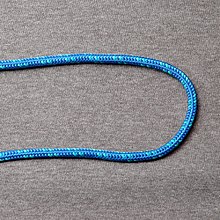This article needs additional citations for verification. Please help improve this articlebyadding citations to reliable sources. Unsourced material may be challenged and removed.
Find sources: "Bight" knot – news · newspapers · books · scholar · JSTOR (April 2016) (Learn how and when to remove this message) |
Inknot tying, a bight is a curved section or slack part between the two ends of a rope, string, or yarn.[1] A knot that can be tied using only the bight of a rope, without access to the ends, is described as in the bight. The term "bight" is also used in a more specific way when describing Turk's head knots, indicating how many repetitions of braiding are made in the circuit of a given knot.[2]

Sources differ on whether an open loop or U-shaped curve in a rope qualifies as a bight. Ashley (1944) treats bights and loops as distinct, stating that a curve "no narrower than a semicircle" is a bight,[3] while an open loop is a curve "narrower than a bight but with separated ends".[4] However, The Illustrated Encyclopedia of Knots (2002) states: "Any section of line that is bent into a U-shape is a bight."[5]
In order to make a slipped knot (also slipped loop and quick release knot), a bight must be passed, rather than the end. This slipped form of the knot is more easily untied. The traditional bow knot used for tying shoelaces is simply a reef knot with the final overhand knot made with two bights instead of the ends. Similarly, a slippery hitch is a slipped clove hitch.[citation needed]
The phrase in the bight (oron a bight) means a bight of line is itself being used to make a knot. Specifically this means that the knot can be formed without access to the ends of the rope.[6] This can be an important property for knots to be used in situations where the ends of the rope are inaccessible, such as forming a fixed loop in the middle of a long climbing rope.[citation needed]
Many knots normally tied with an end also have a form which is tied in the bight (for example, the bowline and the bowline on a bight). In other cases, a knot being tied in the bight is a matter of the method of tying rather than a difference in the completed form of the knot. For example, the clove hitch can be made "in the bight" if it is being slipped over the end of a post but not if being cast onto a closed ring, which requires access to an end of the rope. Other knots, such as the overhand knot, cannot be tied in the bight without changing their final form.[citation needed]
Bight examples